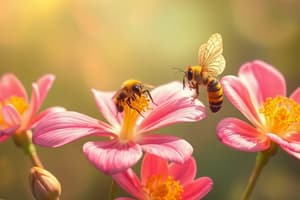Podcast
Questions and Answers
Which reproductive process in plants involves the fusion of sperm and egg to create a zygote?
Which reproductive process in plants involves the fusion of sperm and egg to create a zygote?
- Reproduction through spores
- Sexual reproduction (correct)
- Fragmentation
- Asexual reproduction
What are the male reproductive structures in flowering plants called?
What are the male reproductive structures in flowering plants called?
- Ovules
- Carpels
- Anthers
- Stamens (correct)
How do male gametes reach the female gametes in flowering plants?
How do male gametes reach the female gametes in flowering plants?
- Through spores
- Through fragmentation
- Through pollination (correct)
- Through anthers
In which plant types does reproduction occur through spores?
In which plant types does reproduction occur through spores?
Which of the following is an example of asexual reproduction in plants?
Which of the following is an example of asexual reproduction in plants?
What are the female reproductive structures in flowering plants called?
What are the female reproductive structures in flowering plants called?
What is the primary purpose of pollination in plants?
What is the primary purpose of pollination in plants?
Why are insects considered crucial agents of pollination?
Why are insects considered crucial agents of pollination?
What happens during fertilization in plants?
What happens during fertilization in plants?
What is the role of the ovary wall after fertilization in plants?
What is the role of the ovary wall after fertilization in plants?
Which statement accurately describes seed dispersal mechanisms in plants?
Which statement accurately describes seed dispersal mechanisms in plants?
What is the significance of plant reproductive adaptations mentioned in the text?
What is the significance of plant reproductive adaptations mentioned in the text?
Flashcards are hidden until you start studying
Study Notes
Reproductive Processes in Plants
Plants, unlike animals, don't have a central nervous system, yet they still possess a complex and intricate reproductive system that ensures their survival and propagation. As you delve into the world of plant reproduction, you'll find a captivating blend of biochemistry, genetics, and ecology that provides the foundation for understanding how plants reproduce and adapt to their environment.
Basic Concepts
Plant reproduction happens through two main methods: sexual and asexual.
Sexual reproduction involves the fusion of sperm (male gamete) and egg (female gamete) to create a zygote, which develops into a new individual. In flowering plants, this process occurs in the flower, where pollen (male gametes) are released from the anther and are transferred to the stigma (female gametes) via wind, water, or animals (pollinators). In ferns, club mosses, and horsetails, reproduction occurs through spores, a more primitive form of sexual reproduction.
Asexual reproduction, on the other hand, does not involve the fusion of gametes. Instead, it produces genetically identical offspring through methods such as fragmentation, root or stem cuttings, budding, and apomixis.
Male and Female Components
In flowering plants, the male reproductive structures are stamens, which contain the pollen-producing anthers. The female reproductive structures are carpels, which become the ovules, containing the egg cells. After fertilization, the ovules develop into seeds.
Pollination
The transfer of pollen from the anther to the stigma, which is essential for fertilization, is known as pollination. Wind, water, and animals are the primary agents of pollination. Insects are particularly important because they can transport pollen over longer distances and increase the likelihood of cross-pollination, which leads to genetic variation and greater adaptability in the plant population.
Fertilization
Fertilization occurs when pollen grains reach the stigma and their tubes grow down to the ovules. The sperm (male gametes) inside the pollen grain move through the pollen tube into the ovule, where they fuse with the egg cell to form a zygote.
Seed Development
After fertilization, the ovule develops into a seed, which contains the embryo and the food reserves to support its growth. The ovary wall develops into a fruit, which protects the seeds and aids in seed dispersal.
Seed Dispersal
While some plants rely on animals, water, and wind to disperse their seeds, others have evolved unique seed dispersal mechanisms, such as exploding seeds (burdock), sticky seeds (cocklebur), and winged seeds (maple). These strategies help plants colonize new habitats and ensure their survival.
Adaptations and Speciation
Plants have evolved numerous reproductive adaptations, such as self or mutual pollination, dioecy (separate male and female plants), and cleistogamy (self-pollination in closed flowers), which promote survival and speciation.
Understanding plant reproduction is crucial in agriculture, ecology, and conservation. It provides insight into the factors affecting genetic variation, plant adaptation, and evolution, and informs strategies for crop improvement, invasive species management, and ecosystem conservation. Dafni, A. (2019). Plant Reproduction. In J. Janick & J. Eadie (Eds.), Encyclopedia of Horticulture, Volume 7 (pp. 297-314). Springer. Raven, P. H., Evert, R. F., & Eichhorn, S. E. (2005). Biology of plants, 7th edition. W. H. Freeman and Company. Neumann, P. (2008). Plant Reproduction and Development. Elsevier.
Studying That Suits You
Use AI to generate personalized quizzes and flashcards to suit your learning preferences.




